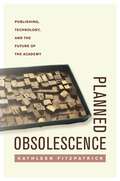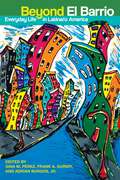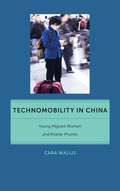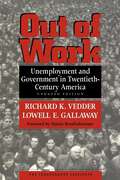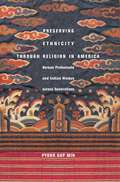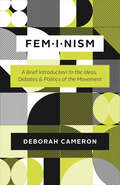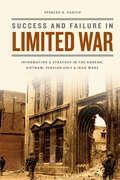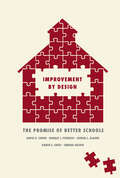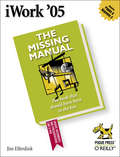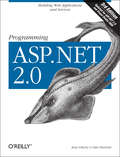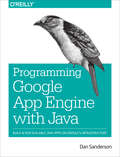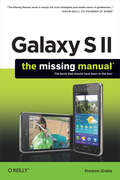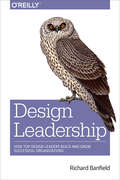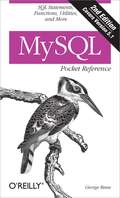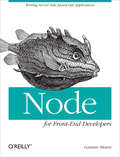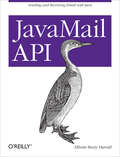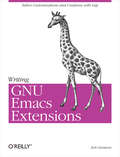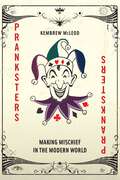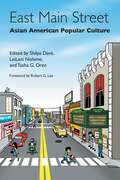- Table View
- List View
Planned Obsolescence: Publishing, Technology, and the Future of the Academy
by Kathleen FitzpatrickChoice's Outstanding Academic Title list for 2013A bold approach to re-envisioning the future of academic publishingAcademic institutions are facing a crisis in scholarly publishing at multiple levels: presses are stressed as never before, library budgets are squeezed, faculty are having difficulty publishing their work, and promotion and tenure committees are facing a range of new ways of working without a clear sense of how to understand and evaluate them.Planned Obsolescence is both a provocation to think more broadly about the academy’s future and an argument for re-conceiving that future in more communally-oriented ways. Facing these issues head-on, Kathleen Fitzpatrick focuses on the technological changes—especially greater utilization of internet publication technologies, including digital archives, social networking tools, and multimedia—necessary to allow academic publishing to thrive into the future. But she goes further, insisting that the key issues that must be addressed are social and institutional in origin.Springing from original research as well as Fitzpatrick’s own hands-on experiments in new modes of scholarly communication through MediaCommons, the digital scholarly network she co-founded, Planned Obsolescence explores these aspects of scholarly work, as well as issues surrounding the preservation of digital scholarship and the place of publishing within the structure of the contemporary university. Written in an approachable style designed to bring administrators and scholars into a conversation, Planned Obsolescence explores both symptom and cure to ensure that scholarly communication will remain relevant in the digital future.Related Articles:"Do 'the Risky Thing' in Digital Humanities"—Chronicle of Higher Education"Academic Publishing and Zombies"—Inside Higher Ed
Beyond El Barrio: Everyday Life in Latina/o America
by Gina M. Pérez Frank A. Guridy Adrian Burgos Jr.Freighted with meaning, “el barrio” is both place and metaphor for Latino populations in the United States. Though it has symbolized both marginalization and robust and empowered communities, the construct of el barrio has often reproduced static understandings of Latino life; they fail to account for recent demographic shifts in urban centers such as New York, Chicago, Miami, and Los Angeles, and in areas outside of these historic communities.Beyond El Barrio features new scholarship that critically interrogates how Latinos are portrayed in media, public policy and popular culture, as well as the material conditions in which different Latina/o groups build meaningful communities both within and across national affiliations. Drawing from history, media studies, cultural studies, and anthropology, the contributors illustrate how despite the hypervisibility of Latinos and Latin American immigrants in recent political debates and popular culture, the daily lives of America’s new “majority minority” remain largely invisible and mischaracterized.Taken together, these essays provide analyses that not only defy stubborn stereotypes, but also present novel narratives of Latina/o communities that do not fit within recognizable categories. In this way, this book helps us to move “beyond el barrio”: beyond stereotype and stigmatizing tropes, as well as nostalgic and uncritical portraits of complex and heterogeneous range of Latina/o lives.
Technomobility in China: Young Migrant Women and Mobile Phones (Critical Cultural Communication #11)
by Cara WallisWinner of the 2014 Bonnie Ritter Book AwardWinner of the 2013 James W. Carey Media Research AwardAs unprecedented waves of young, rural women journey to cities in China, not only to work, but also to “see the world” and gain some autonomy, they regularly face significant institutional obstacles as well as deep-seated anti-rural prejudices. Based on immersive fieldwork, Cara Wallis provides an intimate portrait of the social, cultural, and economic implications of mobile communication for a group of young women engaged in unskilled service work in Beijing, where they live and work for indefinite periods of time.While simultaneously situating her work within the fields of feminist studies, technology studies, and communication theory, Wallis explores the way in which the cell phone has been integrated into the transforming social structures and practices of contemporary China, and the ways in which mobile technology enables rural young women—a population that has been traditionally marginalized and deemed as “backward” and “other”—to participate in and create culture, allowing them to perform a modern, rural-urban identity. In this theoretically rich and empirically grounded analysis, Wallis provides original insight into the co-construction of technology and subjectivity as well as the multiple forces that shape contemporary China.
Out of Work: Unemployment and Government in Twentieth-Century America
by Richard K Vedder Lowell E. GallawayArgues the cause of unemployment may be the government itselfRedefining the way we think about unemployment in America today, Out of Work offers devastating evidence that the major cause of high unemployment in the United States is the government itself.
Preserving Ethnicity through Religion in America: Korean Protestants and Indian Hindus across Generations
by Pyong Gap Min2012 Honorable Mention Award, Sociology of Religion Section, presented by the American Sociological Association2011 Honorable Mention for the American Sociological Association International Migration Section's Thomas and Znaniecki Best BookPreserving Ethnicity through Religion in America explores the factors that may lead to greater success in ethnic preservation. Pyong Gap Min compares Indian Americans and Korean Americans, two of the most significant ethnic groups in New York, and examines the different ways in which they preserve their ethnicity through their faith. Does someone feel more “Indian” because they practice Hinduism? Does membership in a Korean Protestant church aid in maintaining ties to Korean culture?Pushing beyond sociological research on religion and ethnicity which has tended to focus on whites or on a single immigrant group or on a single generation, Min also takes actual religious practice and theology seriously, rather than gauging religiosity based primarily on belonging to a congregation. Fascinating and provocative voices of informants from two generations combine with telephone survey data to help readers understand overall patterns of religious practices for each group under consideration. Preserving Ethnicity through Religion in America is remarkable in its scope, its theoretical significance, and its methodological sophistication.
Habitats: Private Lives in the Big City
by Constance RosenblumThere may be eight million stories in the Naked City, but there are also nearly three million dwelling places, ranging from Park Avenue palaces to Dickensian garrets and encompassing much in between. The doorways to these residences are tantalizing portals opening onto largely invisible lives. Habitats offers 40 vivid and intimate stories about how New Yorkers really live in their brownstones, their apartments, their mansions, their lofts, and as a whole presents a rich, multi-textured portrait of what it means to make a home in the world’s most varied and powerful city. These essays, expanded versions of a selection of the Habitats column published in the Real Estate section of The New York Times, take readers to both familiar and remote sections of the city—to history-rich townhouses, to low-income housing projects, to out-of-the-way places far from the beaten track, to every corner of the five boroughs—and introduce them to a wide variety of families and individuals who call New York home. These pieces reveal a great deal about the city’s past and its rich store of historic dwellings. Along with exploring the deep and even mystical connections people feel to the place where they live, these pieces, taken as a whole, offer a mosaic of domestic life in one of the world’s most fascinating cities and a vivid portrait of the true meaning of home in the 21st-century metropolis.
The Rise of Wisdom Moon (Clay Sanskrit Library #1)
by Krishna mishraThe Rise of Wisdom Moon was composed during the mid-eleventh century by Krishna mishra, an otherwise unknown poet in the service of the Chandella dynasty, whose cultural and religious capital was Khajuraho. The early popularity of Krishna mishra’s work led to its frequent translation into the vernaculars of both North and South India, and even Persian as well. Famed as providing the enduring model of the allegorical play for all subsequent Sanskrit literature, The Rise of Wisdom Moon offers a satirical account of the conquest of the holy city of Benares by Nescience, of the war of liberation waged by the forces of Intuition, and of the freedom of the Inner Man that then follows the rise of Wisdom. But at the outset, when Nescience still has the upper hand, with minions like Lord Lust, such developments seem unlikely.
Battleground of Desire: The Struggle for Self -Control in Modern America
by Peter N. StearnsIn recent years, Peter N. Stearns has established himself as the foremost historian of American emotional life. In books on anger, jealousy, "coolness," and body image, he has mapped out the basic terrain of the American psyche. Now Stearns crowns his work of the past decade with this powerful volume, in which he reveals the fundamental dichotomy at the heart of the national character: a self-indulgent hedonism and the famed American informality on the one hand, and a deeply imbedded repressiveness on the other. Whether hunting and gathering tribe or complex industrial civilization, every social group is governed by explicit and implicit guidelines on how to behave. But these definitions vary widely. The Japanese worry less about public drunkenness than Americans. Northern Europeans adhere to stricter standards than Americans when it comes to littering. Today, we swear more now and spit less, discuss sex more and death less. With an emphasis on sex, culture, and discipline of the body, Stearns traces how particular anxieties take root, and how they express inherent tension in contemporary standards and a stubborn nostalgia for the previous nineteenth century regime. Battleground of Desire explodes common wisdom about Americans in the twentieth century as normless and tolerant, emphasizing that most of us follow a litany of rules, governing everything from adultery to bad breath.
Feminism: A Brief Introduction to the Ideas, Debates & Politics of the Movement (Ideas In Profile Ser.)
by Deborah CameronCommunications academic Deborah Cameron explores the history and diversity of Feminism as an ideology and political movement.Beneath the nonstop cacophony of voices across social media, online forums, and news outlets lie the stubborn facts at the heart of the everyday struggles of women today: more than a third of single moms live in poverty; the United States sees more maternal deaths than anywhere else in the developed world; one in five women will be raped in her lifetime; and women still make eighty cents for every dollar earned by a man. Between these brutal statistics and the ill-informed, often contentious public debate stand millions of women who feel alienated, disaffected, or just plain worn out.In the era of #MeToo, Trump, and online harassment, innovative progressive feminist voices are more essential than ever. With this book, Deborah Cameron considers feminism from all sides—as an idea, as a theoretical approach, and as a political movement. Written in the succinct, sharp style that has made Cameron’s feminist linguistics blog so popular, this short book lays out past and present debates on seven key topics: domination, rights, work, femininity, sex, culture, and the future. Feminism emphasizes the diversity of feminist thought, including queer, women-of-color, and trans perspectives. Cameron’s clear and incisive account untangles the often confusing strands of one of history’s most important intellectual and political movements.Broad in scope but refreshingly concise, this book is perfect for anyone who needs a straightforward primer on the complex history of feminism, a nuanced explanation of key issues and debates, or strategic thinking about the questions facing activists today.
Success and Failure in Limited War: Information & Strategy in the Korean, Vietnam, Persian Gulf & Iraq Wars
by Spencer D. BakichCommon and destructive, limited wars are significant international events that pose a number of challenges to the states involved beyond simple victory or defeat. Chief among these challenges is the risk of escalation—be it in the scale, scope, cost, or duration of the conflict. In this book, Spencer D. Bakich investigates a crucial and heretofore ignored factor in determining the nature and direction of limited war: information institutions. Traditional assessments of wartime strategy focus on the relationship between the military and civilians, but Bakich argues that we must take into account the information flow patterns among top policy makers and all national security organizations. By examining the fate of American military and diplomatic strategy in four limited wars, Bakich demonstrates how not only the availability and quality of information, but also the ways in which information is gathered, managed, analyzed, and used, shape a state’s ability to wield power effectively in dynamic and complex international systems. Utilizing a range of primary and secondary source materials, Success and Failure in Limited War makes a timely case for the power of information in war, with crucial implications for international relations theory and statecraft.
Improvement by Design: The Promise of Better Schools
by David K. Cohen Donald J. Peurach Joshua L. Glazer Karen E. Gates Simona GoldinOne of the great challenges now facing education reformers in the United States is how to devise a consistent and intelligent framework for instruction that will work across the nation’s notoriously fragmented and politically conflicted school systems. Various programs have tried to do that, but only a few have succeeded. Improvement by Design looks at three different programs, seeking to understand why two of them—America’s Choice and Success for All—worked, and why the third—Accelerated Schools Project—did not. The authors identify four critical puzzles that the successful programs were able to solve: design, implementation, improvement, and sustainability. Pinpointing the specific solutions that clearly improved instruction, they identify the key elements that all successful reform programs share. Offering urgently needed guidance for state and local school systems as they attempt to respond to future reform proposals, Improvement by Design gets America one step closer to truly successful education systems.
iWork '05: The Missing Manual (Missing Manual)
by Jim ElferdinkIntroduced by Apple in January 2005, iWork '05 is an innovative new suite of document and presentation software that's the same caliber as Apple's groundbreaking digital media applications and that's wholly dedicated to what Mac users like you care about most: artistry and creativity. iWork '05 isn't about "office productivity"--it's about creating slick and stylish documents and cinema-quality digital presentations that say precisely what you want them to say.While iWork '05 helps you create stunning documents and presentations, the suite doesn't come with any in-depth documentation of its own. That's where iWork '05: The Missing Manual comes in. The book that should have been in the box, it gives you everything you need to master iWork '05. Seamlessly integrated with the wildly popular iLife '05 and designed to take advantage of the advanced typography and graphics engine of Mac OS X, iWork is actually two separate programs: Pages and Keynote 2. Pages is a brand-new, streamlined word processor and page layout program that allows nonprofessionals to quickly and painlessly produce gorgeous brochures, newsletters, letters, invitations, product data sheets, and more. You can start documents from scratch or use one of the 40 professionally designed templates as a starting point. Keynote 2 is a significant upgrade to Keynote, Apple's PowerPoint-like presentation software that allows you to build unique presentations, demonstrations, storyboard animations, interactive slideshows, and more. Like every Missing Manual, this one is refreshingly entertaining and scrupulously detailed. iWork '05: The Missing Manual gives you all the essentials of Pages and Keynote 2, including an objective look at each program's capabilities, its advantages over similar programs, and its limitations. The book delivers countless goodies that you won't find anywhere else: undocumented tips, tricks, and secrets for getting the very best results from both exciting new applications. With the iWork '05 suite and iWork '05: The Missing Manual, you are totally equipped to give your work the style it deserves.
Programming ASP.NET: Building Web Applications and Services with ASP.NET 2.0
by Jesse Liberty Dan HurwitzO'Reilly has once again updated its bestselling tutorial on ASP.NET, the world's leading web development tool from Microsoft. In Programming ASP.NET, Third Edition, authors Jesse Liberty and Dan Hurwitz give you the lowdown on the technology's latest version, ASP.NET 2.0, as well as Visual Studio 2005.Among the most significant improvements to ASP.NET 2.0 are new server controls and services that make you dramatically more productive. In fact, when compared to its predecessor, ASP.NET 2.0 reduces the amount of code you have to write by about 75%. Creating interactive web applications has never been easier-but that still doesn't mean it's hassle-free! The difficulty in ASP.NET 2.0 is that it's so complete and flexible that there are many pieces that must be woven together to build a robust, scalable, and efficient application.Fortunately, Programming ASP.NET, Third Edition is on the case, dispensing all the information you need to be effective with this dynamic tool. For starters, the book features a comprehensive tutorial on Web Forms, the user interface that gives web applications their look and feel. It then offers detailed explanations of all new controls, including web server controls, HTML controls, and custom controls. Used properly, these controls are able to take care of nearly all the foundation work-security, data access, layout, etc.-that you would normally have to write yourself. Free of these burdensome tasks, you can instead focus on your specific application.Other new material found in this updated edition even shows you how to create ASP.NET 2.0 pages for mobile devices. With Programming ASP.NET, Third Edition at your side, there's virtually no end to the programming possibilities.
Programming Google App Engine with Java: Build & Run Scalable Java Applications on Google's Infrastructure
by Dan SandersonThis practical guide shows intermediate and advanced web and mobile app developers how to build highly scalable Java applications in the cloud with Google App Engine. The flagship of Google's Cloud Platform, App Engine hosts your app on infrastructure that grows automatically with your traffic, minimizing up-front costs and accommodating unexpected visitors. You’ll learn hands-on how to perform common development tasks with App Engine services and development tools, including deployment and maintenance.For Java applications, App Engine provides a J2EE standard servlet container with a complete Java 7 JVM and standard library. Because App Engine supports common Java API standards, your code stays clean and portable.Get a hands-on introduction to App Engine's tools and features, using an example applicationSimulate App Engine on your development machine directly from EclipseStructure your app into individually addressable modules, each with its own scaling configurationExploit the power of the scalable Cloud Datastore, using queries, transactions, and data modeling with JPAUse Cloud SQL for standard relational databases with App Engine applicationsLearn how to deploy, manage, and inspect your application on Google infrastructure
Galaxy S II: The Missing Manual
by Preston GrallaUnlock the potential of Samsung's Galaxy S II with this jargon-free guide from technology guru Preston Gralla. You’ll quickly learn how to shoot high-res photos and HD video, keep your schedule, stay in touch, and enjoy your favorite media. Every page is packed with illustrations and valuable advice to help you get the most from the smartest phone in town. (Note: This book does not cover the Galaxy S3, Galaxy S4, and later models.)The important stuff you need to know:Get dialed in. Learn your way around the Galaxy S II’s calling and texting features.Go online. Browse the Web, manage email, and download apps with Galaxy S II’s 3G/4G network (or create your own hotspot).Master your media. Shoot and share pictures and video, organize and play your music library—and send it wirelessly to your TV or stereo.Be entertained now. Start watching movies and TV shows while they’re still loading.Explore the world. Get news and weather, find a location, and navigate by GPS.Check your schedule. Use the convenient calendar app, and sync it with your Google and Outlook calendars.Preston Gralla is the author of more than 40 books, including Missing Manuals on Droid X2, Xoom, and Galaxy Tab. He’s the editor of WindowsDevCenter.com and OnDotNet, and a contributing editor to Computerworld.
Testing in Scala: Scala Tools for Behavior-Driven Development
by Daniel HinojosaIf you build your Scala application through Test-Driven Development, you’ll quickly see the advantages of testing before you write production code. This hands-on book shows you how to create tests with ScalaTest and the Specs2—two of the best testing frameworks available—and how to run your tests in the Simple Build Tool (SBT) designed specifically for Scala projects.By building a sample digital jukebox application, you’ll discover how to isolate your tests from large subsystems and networks with mocking code, and how to use the ScalaCheck library for automated specification-based testing. If you’re familiar with Scala, Ruby, or Python, this book is for you.Get an overview of Test-Driven DevelopmentStart a simple project with SBT and create tests before you write codeDive into SBT’s basic commands, interactive mode, packaging, and historyUse ScalaTest both in the command line and with SBT, and learn how to incorporate JUnit and TestNGWork with the Specs2 framework, including Specification styles, matchers DSLs, and Data TablesUnderstand mocking by using Java frameworks EasyMock and Mockito, and the Scala-only framework ScalaMockAutomate testing by using ScalaCheck to generate fake data
Design Leadership: How Top Design Leaders Build and Grow Successful Organizations
by Richard BanfieldWhat does it take to be the leader of a design firm or group? We often assume they have all the answers, but in this rapidly evolving industry they’re forced to find their way like the rest of us. So how do good design leaders manage? If you lead a design group, or want to understand the people who do, this insightful book explores behind-the-scenes strategies and tactics from leaders of top design companies throughout North America.Based on scores of interviews he conducted over a two-year period—from small companies to massive corporations like ESPN—author Richard Banfield covers a wide range of topics, including:How design leaders create a healthy company cultureInnovative ways for attracting and nurturing talentCreating productive workspaces, and handling remote employeesStaying on top of demands while making time for themselvesConsistent patterns among vastly different leadership stylesTechniques and approaches for keeping the work pipeline fullMaking strategic and tactical plans for the futureMistakes that design leaders made—and how they bounced back
MySQL Pocket Reference: SQL Functions and Utilities
by George ReeseTo help you be more efficient in your work, this handy pocket reference gives you instant reminders on how to use important MySQL functions, especially in conjunction with key parts of the LAMP open source infrastructure. This powerful database system is so rich in features that no administrator or programmer can stay familiar with all of them. MySQL Pocket Reference is an ideal on-the-job companion, well organized to help you find and adapt the statements you need -- quickly.Updated for the latest versions of this popular database, this edition covers many complex features that have been added to MySQL 5.0 and 5.1, including a section dedicated to stored procedures and triggers. After a brief introduction on installation and initial setup, the book explains: How to configure MySQL, such as setting the root passwordMySQL data types, including numerics, strings, dates, and complex typesSQL syntax, commands, data types, operators, and functionsArithmetic, comparison and logical operatorsAggregate and general functionsStored procedures and triggers, including procedure definition, procedure calls, procedure management, cursors, and triggersYou don't have time to stop and thumb through an exhaustive reference when you're hard at work. This portable and affordable guide is small enough to fit into your pocket, and gives you a convenient reference that you can consult anywhere. When you reach a sticking point and need to get to a solution quickly, the MySQL Pocket Reference is the book you want to have.
Node for Front-End Developers: Writing Server-Side JavaScript Applications
by Garann MeansIf you know how to use JavaScript in the browser, you already have the skills you need to put JavaScript to work on back-end servers with Node. This hands-on book shows you how to use this popular JavaScript platform to create simple server applications, communicate with the client, build dynamic pages, work with data, and tackle other tasks.Although Node has a complete library of developer-contributed modules to automate server-side development, this book will show you how to program with Node on your own, so you truly understand the platform. Discover firsthand how well Node works as a web server, and how easy it is to learn and use.Set up Node and learn how to build scaffolding for a web applicationWork with Node natively to see how it functions as a web serverUnderstand how Node receives client data from GET and POST requestsUse the Socket.IO module to facilitate realtime client-server communicationChoose from among several Node templates to create dynamic pagesLearn how to connect to a database, and store data in filesImplement the Model-View-Controller pattern, and share Node modules with server and client
JavaMail API: Sending and Receiving Email with Java
by Elliotte Rusty HaroldSend and receive email from Java applications by using the JavaMail API. With this concise book, you’ll learn how to communicate with existing SMTP, POP, and IMAP servers, and how to write your own.Whether you need to build an email-centric application like a mailing list manager or simply add email notification to a larger product, JavaMail is the answer. Packed with code examples, this book shows you how JavaMail enables you to avoid low-level protocol details, so you can focus on what you actually want to say in a message.Send, receive, and store email with POP3 and IMAPAdd password authentication to your programsManage mailboxes and accountsDownload mail attachmentsRespond to asynchronous email eventsDesign protocol-independent email programs
Writing GNU Emacs Extensions: Editor Customizations and Creations with Lisp
by Bob GlicksteinYes, it is possible to be all things to all people, if you're talking about the Emacs editor. As a user, you can make any kind of customization you want, from choosing the keystrokes that invoke your favorite commands to creating a whole new work environment that looks like nothing ever developed before. It's all in Emacs Lisp -- and in this short but fast-paced book.GNU Emacs is more than an editor; it's a programming environment, a communications package, and many other things. To provide such a broad range of functions, it offers a full version of the Lisp programming language -- something much more powerful than the little macro languages provided in other editors (including older versions of Emacs). GNU Emacs is a framework in which you can create whole new kinds of editors or just alter aspects of the many functions it already provides.In this book, Bob Glickstein delves deep into the features that permit far-reaching Emacs customizations. He teaches you the Lisp language and discusses Emacs topics (such as syntax tables and macro templates) in easy-to-digest portions. Examples progress in complexity from simple customizations to extensive major modes.You will learn how to write interactive commands, use hooks and advice, perform error recovery, manipulate windows, buffers, and keymaps, exploit and alter Emacs's main loop, and more. Each topic is explored through realistic examples and a series of successive refinements that illustrate not only the Emacs Lisp language, but the development process as well, making learning pleasant and natural.
Homeroom Security: School Discipline in an Age of Fear (Youth, Crime, and Justice #6)
by Aaron KupchikPolice officers, armed security guards, surveillance cameras, and metal detectors are common features of the disturbing new landscape at many of today’s high schools. You will also find new and harsher disciplinary practices: zero-tolerance policies, random searches with drug-sniffing dogs, and mandatory suspensions, expulsions, and arrests, despite the fact that school crime and violence have been decreasing nationally for the past two decades. While most educators, students, and parents accept these harsh policing and punishment strategies based on the assumption that they keep children safe, Aaron Kupchik argues that we need to think more carefully about how we protect and punish students.In Homeroom Security, Kupchik shows that these policies lead schools to prioritize the rules instead of students, so that students’ real problems—often the very reasons for their misbehavior—get ignored. Based on years of impressive field research, Kupchik demonstrates that the policies we have zealously adopted in schools across the country are the opposite of the strategies that are known to successfully reduce student misbehavior and violence. As a result, contemporary school discipline is often unhelpful, and can be hurtful to students in ways likely to make schools more violent places. Furthermore, those students who are most at-risk of problems in schools and dropping out are the ones who are most affected by these counterproductive policies. Our schools and our students can and should be safe, and Homeroom Security offers real strategies for making them so.
Pranksters: Making Mischief in the Modern World
by Kembrew McLeodFrom BenjaminFranklin's newspaper hoax that faked the death of his rival to Abbie Hoffman’sattempt to levitate the Pentagon, pranksters, hoaxers, and con artists have causedconfusion, disorder, and laughter in Western society for centuries. Profilingthe most notorious mischief makers from the 1600s to the present day, Prankstersexplores how “pranks” are part of a long tradition of speaking truth to powerand social critique.Invoking such historical and contemporary figures as P.T. Barnum,Jonathan Swift, WITCH, The Yes Men, and Stephen Colbert, Kembrew McLeod showshow staged spectacles that balance the serious and humorous can spark importantpublic conversations. In some instances, tricksters have incited social change(and unfortunate prank blowback) by manipulating various forms of media, fromnewspapers to YouTube. For example, in the 1960s, self-proclaimed “professionalhoaxer” Alan Abel lampooned America’s hypocritical sexual mores by usingconservative rhetoric to fool the news media into covering a satirical organizationthat advocated clothing naked animals. In the 1990s, Sub Pop Recordsthen-receptionist Megan Jasper satirized the commodification of alternativemusic culture by pranking the New YorkTimes into reporting on her fake lexicon of “grunge speak.” Throughout thisbook, McLeod shows how pranks interrupt the daily flow of approved informationand news, using humor to underscore larger, pointed truths.Written in an accessible, story-driven style, Prankstersreveals how mischief makers have left their shocking, entertaining, andeducational mark on modern political and social life.
East Main Street: Asian American Popular Culture
by Robert G. Lee LeiLani Nishime Shilpa Davé Tasha G. OrenAn interdisciplinary anthology of the rich Asian American influence on U.S. popular cultureFrom henna tattoo kits available at your local mall to “faux Asian” fashions, housewares and fusion cuisine; from the new visibility of Asian film, music, video games and anime to the current popularity of martial arts motifs in hip hop, Asian influences have thoroughly saturated the U.S. cultural landscape and have now become an integral part of the vernacular of popular culture. By tracing cross-cultural influences and global cultural trends, the essays in East Main Street bring Asian American studies, in all its interdisciplinary richness, to bear on a broad spectrum of cultural artifacts. Contributors consider topics ranging from early Asian American movie stars to the influences of South Asian iconography on rave culture, and from the marketing of Asian culture through food to the contemporary clamor for transnational Chinese women’s historical fiction. East Main Street hits the shelves in the midst of a boom in Asian American population and cultural production. This book is essential not only for understanding Asian American popular culture but also contemporary U.S. popular culture writ large.
That Ever Loyal Island: Staten Island and the American Revolution
by Phillip PapasOf crucial strategic importance to both the British and the Continental Army, Staten Island was, for a good part of the American Revolution, a bastion of Loyalist support. With its military and political significance, Staten Island provides rich terrain for Phillip Papas's illuminating case study of the local dimensions of the Revolutionary War.Papas traces Staten Island's political sympathies not to strong ties with Britain, but instead to local conditions that favored the status quo instead of revolutionary change. With a thriving agricultural economy, stable political structure, and strong allegiance to the Anglican Church, on the eve of war it was in Staten Island's self-interest to throw its support behind the British, in order to maintain its favorable economic, social, and political climate. Over the course of the conflict, continual occupation and attack by invading armies deeply eroded Staten Island's natural and other resources, and these pressures, combined with general war weariness, created fissures among the residents of “that ever loyal island,” with Loyalist neighbors fighting against Patriot neighbors in a civil war. Papas’s thoughtful study reminds us that the Revolution was both a civil war and a war for independence—a duality that is best viewed from a local perspective.
